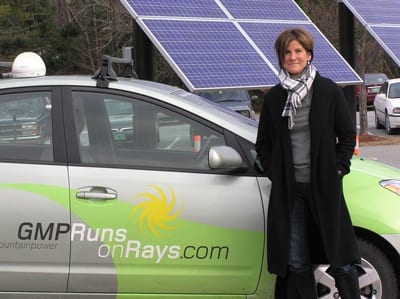When you hear “electric utilities” and “distributed renewables” in the same sentence, probably the first thing that comes to mind is conflict, or perhaps litigation, or perhaps any of the myriad number of ways that many of the larger utilities are working to stifle the growth of distributed capacity.
But it doesn’t have to be that way. Enter, Green Mountain Power, the leading electricity provider in the US state of Vermont. Rather than simply working against the (likely inevitable) spread of distributed generation, the utility has been transforming itself a company with a business model that puts renewable energy and distributed generation at its core.

The reason for the abrupt switch in strategy: simply giving customers what they want. A company that gives its customers what they actually want, who would have ever thought of such a concept?
“Back in 2008 I launched an energy vision for the company which was tied to what customers wanted,” explained Mary Powell, Green Mountain Power’s CEO, “which was renewables and more distributed generation.”
SolarEnergy provides more:
Powell is quick to point out that the company had to go through a radical transformation of its own culture before it could change its outward focus to focusing on customer needs. Green Mountain Power used to be not so different than others in the business, Powell said: stodgy, slow-moving, bureaucratic, costly and focused on terms such as “ratepayers,” “meters,” and “load.”
But when she became CEO in 2008, Powell worked with other leaders in the company to reduce its cost structure and internal culture. One dramatic change Powell implemented was to make over Green Mountain Power’s working environment into an open office — and put her own desk in the middle of it all where she’s accessible to any staff person.
But how does such a model evolve when one needs to keep the ship afloat, yet also stay ahead of the curve? After all, one common argument from utilities is that if a growing number of customers rely less and less on the grid, it’s going to put a greater cost burden on the rest when the utility needs to pay for grid maintenance and upgrades.
“I don’t agree with that,” Powell noted. “It’s an attitude that only stays valid if a utility looks at grid management as something that never changes, she says, and pointed to GMP’s recently announced 2.4% rate decrease.”
Powell does note that if, say, 20% of her company’s customers were to participate in net metering, it would present a challenge, but not one that she is threatened by.
“It’s our job to innovate and we’re providing the new paradigm to offset the cost shift,” she concluded. “Our goal is to keep rates flat while we lean in to change.”
Interesting. Hard to imagine larger utilities willingly going this direction though. It’s probably easier, and cheaper, for many of them to simply try to maintain the status quo for as long as possible.
For an example of the exact opposite approach to Green Mountain Power, I direct you towards our recent article: Florida Utilities Working To Crush Nascent Solar Industry.
The shorthand of the article is that the utilities are using their clout to stop solar advocacy groups from participating in the Public Service Commission policy talks that the utilities themselves do… because the “talks were not intended to promote businesses, to protect business markets, or to protect the competitive economic interests of the solar industry.”
Lol… 🙁
Source: CleanTechnica. Reproduced with permission.










